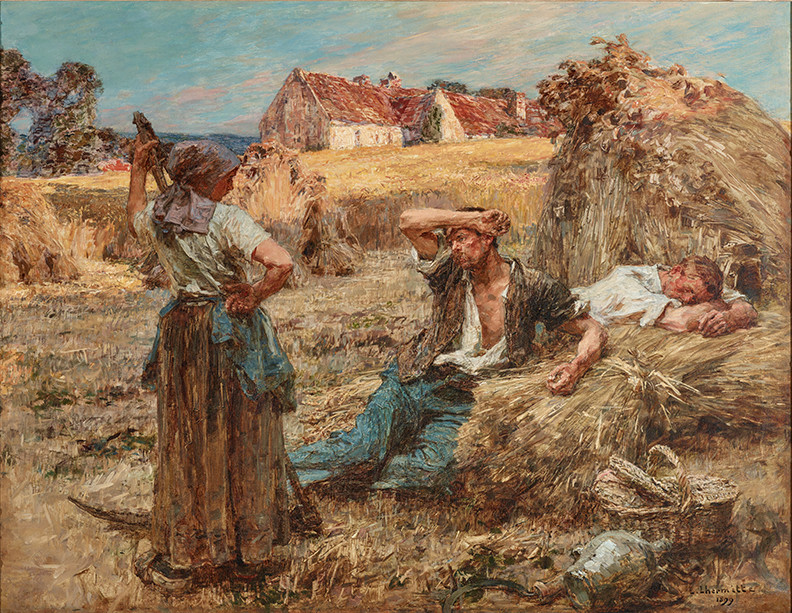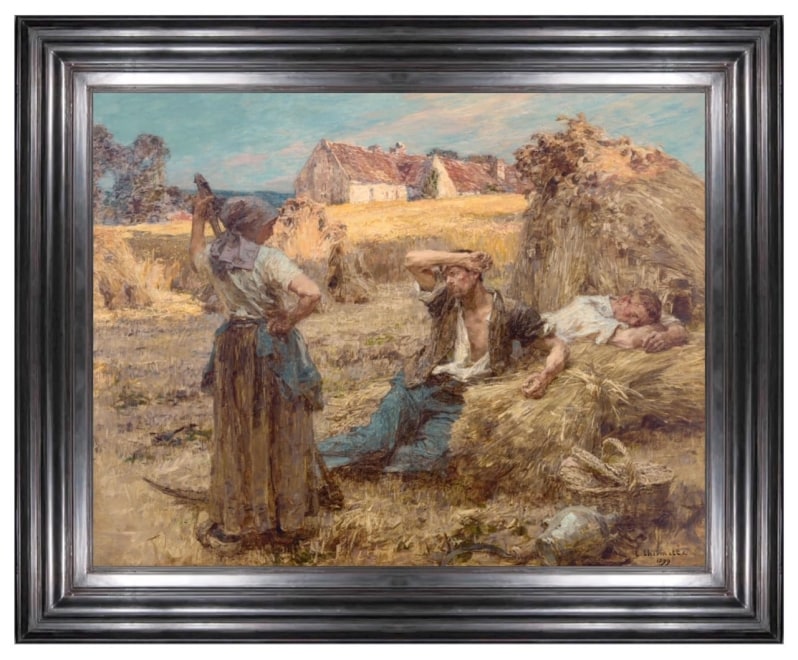Provenance
The artist
Boussod, Valadon et Cie., Paris, 19 April 1899 (no. 25662, acquired directly from the above)
Arthur Tooth & Son, London, 19 April 1899 (acquired directly from the above).
Thomas McLean's Gallery, London, by October 1901.
George MacCulloch (1848-1907) and Mary Agnes Coutts Michie (1857-1945), London (and sold: Christie's, London, 23 May 1913, lot 31, as Noonday Rest)
Arthur Tooth & Sons, London, Boussod, Valadon et Cie., Paris, and Wallis & Son (acquired jointly from the above)
H. Young, 1918 (sold by Arthur Tooth & Sons, London)
Annie Rae Poth (1907-2001), Galveston, TX.
St. Stephen's Episcopal School, Austin, TX (gifted by the above) (and sold: Christie's, New York, 30 October 2002, lot 26)
Arnold and Anne Ulnick Gumowitz, New York (acquired at the above sale)
Exhibited
Paris, Salon, 1899, no. 949.
London, Thomas McLean's Gallery, Annual Winter Exhibition, October 1901, no. 21, as Noonday Rest.
London, Royal Academy, Exhibition of Modern Works in Painting and Sculpture Forming the Collection of the Late George McCulloch, Esq., 4 January-13 March 1909, no. 194, as Noonday Rest.
Glasgow, The Glasgow International Exhibition, 1901, no. 1271, as Harvesters.
Literature
A. Pallier, La Liberté, Paris, 29 April 1899, p. 2.
O. De Gourcuff, “Le salon de 1899,” L’estafette, Paris, 30 April 1899, np.
G. Geoffroy, “Les salons de 1899,” Le Journal, Paris, 30 April 1899, p. 1.
G. Mercy, “Les salons,” Libre Parole. supplément, Paris, 30 April 1899, np.
De la Cymaise, Le Soir, Brussels, 1 May 1899, np.
O. Uzanne, “Société nationale des beaux-arts,” L'Écho de Paris, Paris, 1 May 1899, p. 1.
H. Rochefort, “Rochefort Reviews Beaux-Arts Salon,” New York Herald, New York, 1 May 1899, p. 9.
Torpedo, Le Jour, Paris, 1 May 1899.
Valensol, “Le salon de la Société nationale,” Le Petit Parisien, Paris, 1 May 1899, p. 2.
H. Ayraud-Degeorge, “Les salon de 1899,” L'Intransigeant, Paris, 2 May 1899, p. 2.
Mécène, L'autorité, Paris, 2 May 1899, np.
“Le Salon de 1899,” La Nation, Paris, 2 May 1899, np.
Le Progrès de l'Aisne, Saint-Quentin, 2 May 1899, np.
“Les artistes de l'Aisne,” Le Guetteur, 5 May 1899, Saint-Quentin, np.
G. Morot, La Presse, Paris, 7 May 1899, np.
H. Bernard, Union Républicaine, Roubaix, 10 May 1899, np.
H. Dac, “Les salons de 1899,” L'Univers, Paris, 15 May 1899, as Réveil, np.
H. Eon, La Plume, Paris, 15 May 1899, np.
R. de la Sizeranne, La Revue des Deux Mondes, Paris, 15 May 1899, np.
J. d'Esnitot, “Beaux-arts, les salons de 1899, ” La mode de style, Paris, 17 May 1899, p. 260.
Guillemot, Le Messager de Paris, Paris, 27 May 1899, np.
F. Mair, Revue Populaire des Beaux-Arts, Paris, 27 May 1899, np.
C. Das, “Salon de peinture,” Le Petit Caporal, Paris, 5 June 1899, p. 2.
La Petite Loire, Saumur, 8 June 1899, np.
Quolibet, “Salon de la Société nationale,” Le Tintamarre, Paris, 11 June 1899, np.
O. Merson, “Les salons de 1899,” Le Monde Illustré, Paris, 1 July 1899, p. 3.
“Les Livres,” L'Intransigeant, Paris, 8 July 1899, p. 3.
E. Maton, “Les salons,” Revue Septentrionale, Paris, 1899, p. 141.
A. Alexandre, Figaro-Salon, Paris, 1899, p. 85, illustrated with the engraving.
A. Proust, Salon of 1899, New York and Paris, 1899, ill. 72, illustrated with the engraving.
“Forthcoming Sale of Modern Pictures,” The New York Herald, Paris, 6 April 1913, p. 8, as Noonday Rest.
“The McCulloch Collection,” The Athenaeum, London, 31 May 1913, p. 598, as Noonday Rest.
“In the Sale Room,” The Connoisseur, London, May-August 1913, p. 192, as Noonday Rest.
M. Hamel, A French artist : Léon Lhermitte, Washington University, dissertation, 1974, no. 242 as Le réveil du faucheur, p.44, ill. p. C245
M. Le Pelley Fonteny, Léon Augustin Lhermitte (1844-1925): catalogue raisonné, Paris, 1991, pp. 138-139, no. 172, illustrated, as Le réveil du faucheur ou le repos du moissonneur.
Catalogue note
In Le Repos du Faucheur, Lhermitte portrays a group of three reapers, farm laborers who harvest crops, taking a momentary respite from their arduous work. One woman stands, her back turned to the viewer, leaning on her scythe, the instrument of her labor. Another figure on the right is asleep, using a bundle of hay as a makeshift pillow. Although our painting dates from 1899, it recalls Lhermitte’s earlier work. During that period, he portrayed the modern-day peasant as a mythological or historical hero, dignified, proud, and in large formats. The central figure in our painting, shown stretching on the ground after his mid-day nap with his right arm resting on his forehead, echoes the gesture from the peasant in La Moisson (1883), one of Lhermitte’s most celebrated scenes from his early period. Unlike Jean-François Millet, Lhermitte was concerned with depicting the heroism of the field worker, but as an individual rather than a type. In our painting, the figures are not simply representatives of a class. They are actual, identifiable individuals from Lhermitte’s village, self-aware and self-motivated. The present scene is a living reality; rural life does not represent the past but the present.
Lhermitte’s dedication to intricate details is evident in every aspect of the painting. He skillfully captures the textures of the peasants’ clothing, the hatched stalks of wheat, the roughness of the wooden scythe, and the play of light across the surrounding landscape. The composition exudes a profound sense of humanity, encapsulating the inherent dignity in the life of a laborer and underscoring the significance of taking a moment of reprieve amidst demanding work. The weary yet serene expressions on the faces depict their exhaustion yet also their tranquility. The painting is bathed in warm, golden tones, creating a serene ambiance that enhances the sense of peaceful contemplation and relaxation.
Le Repos du Faucheur serves as a poignant tribute to the resilience of the rural French workforce, highlighting their inherent strength and endurance. Lhermitte’s remarkable ability to infuse ordinary scenes with profound emotion and meaning attests to his skill in capturing the everyday lives of peasants with deep empathy and precision. His work transcends time, resonating universally and making it a relatable masterpiece.




